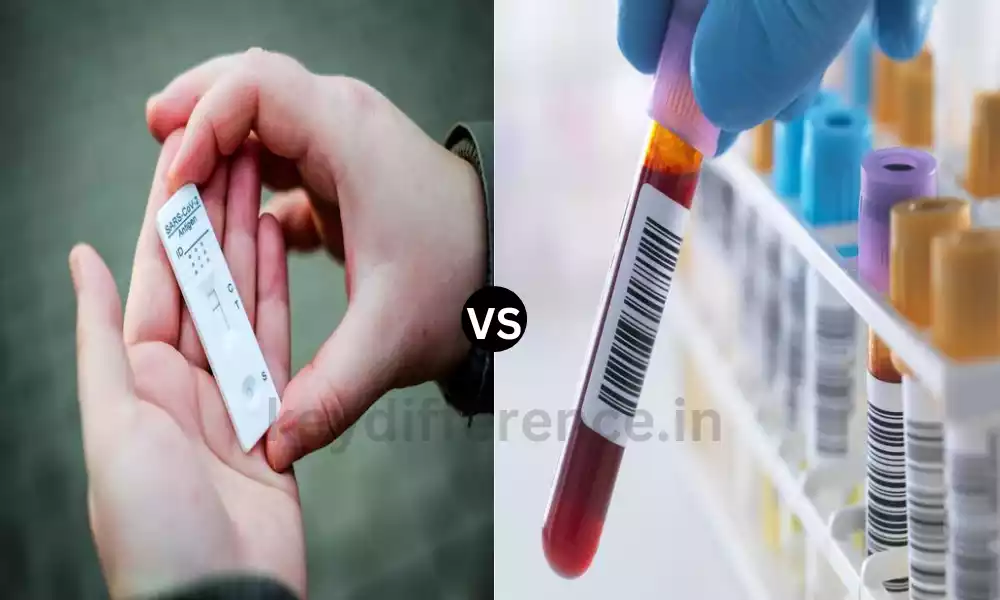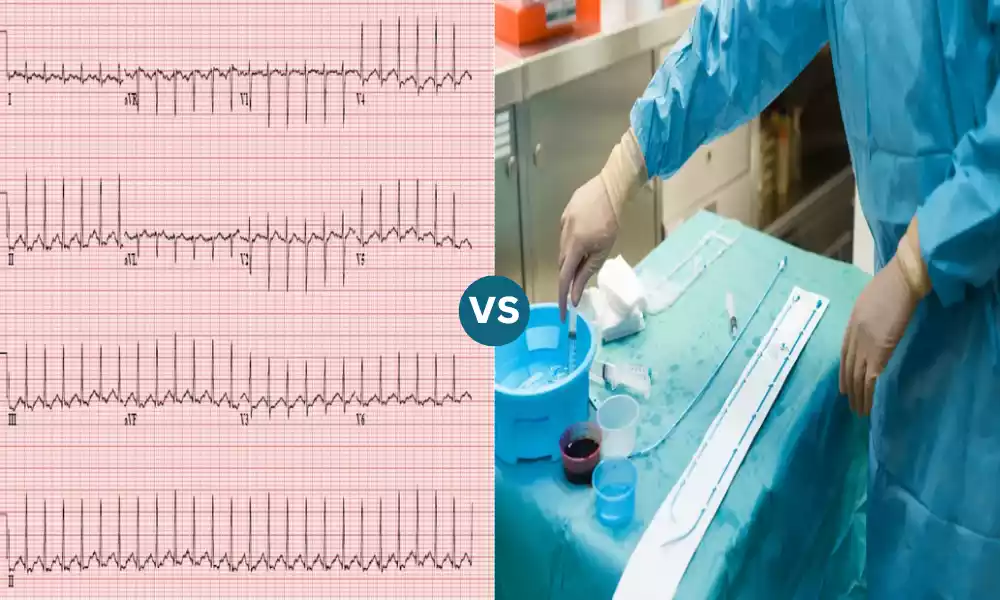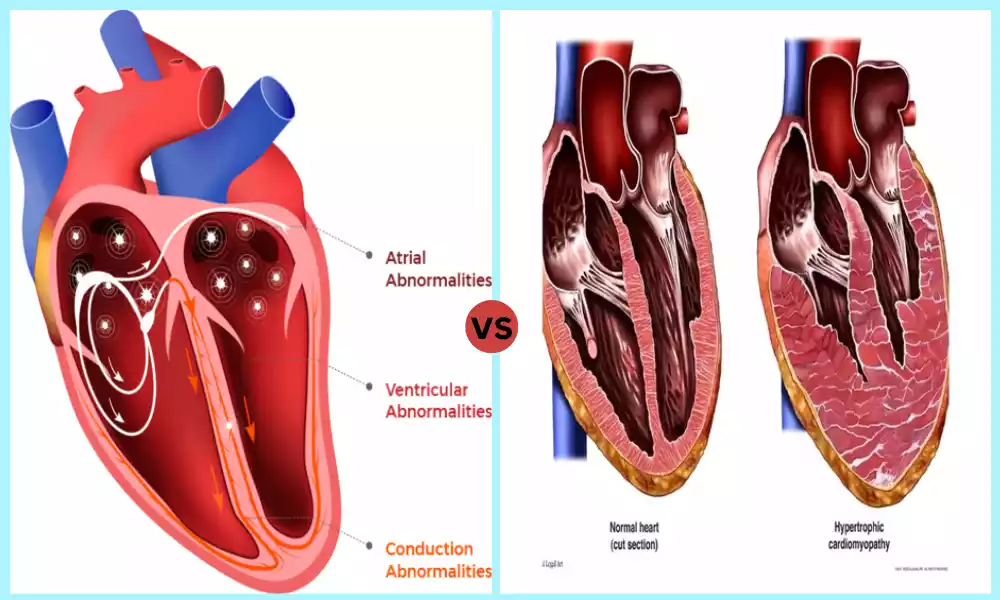Diagnostic testing plays an important function in the identification and management of the spread of infectious diseases. Two types of tests commonly that are used to detect these diseases are tests for antigens and nucleic acid amplifying tests (NAATs).
Knowing the distinctions between Antigen and NAAT Test is vital for health professionals and those looking for a timely and accurate diagnosis. We will explore the differences between antigen tests and NAAT tests. We will also explore their underlying principles, application, and practical aspects.
What is an Antigen Test?
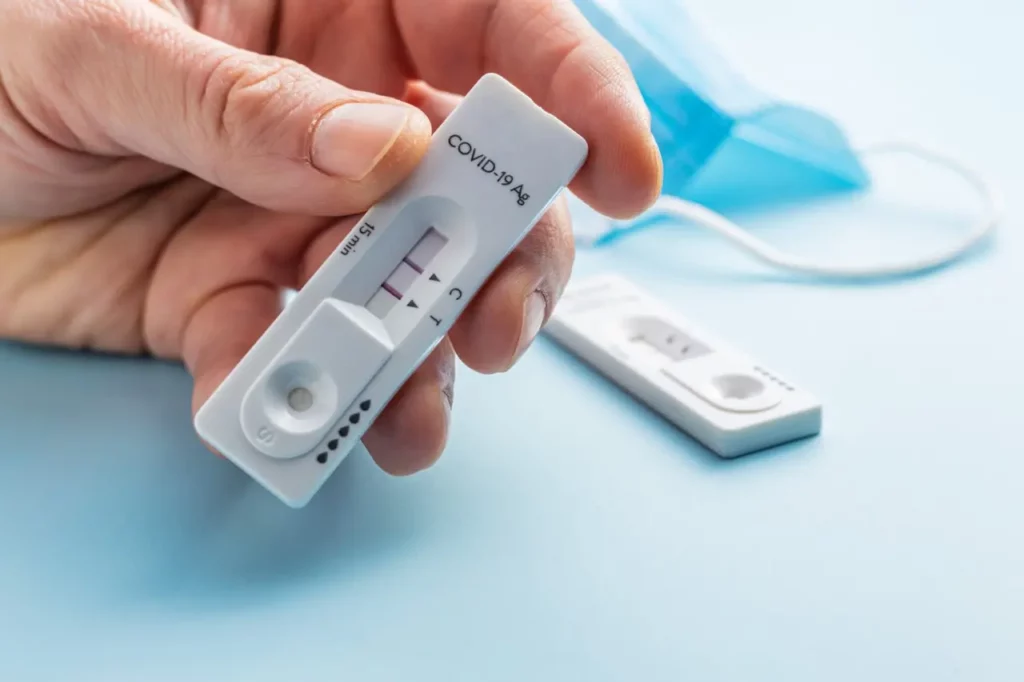
Antigen tests, sometimes referred to by the name of rapid antigen tests are diagnostic tests that determine the presence of specific bacteria or viral proteins (antigens) in the biological samples of a patient generally via swabs from the throat or nose.
The tests are typically used to determine the presence of a disease that is active because they are able to detect antigens from viruses produced by the pathogen within the body. Antigen tests are renowned for their speed and are commonly employed for screening that is quick and can provide results within minutes, which makes them useful instruments in early diagnosis and prevention of infectious diseases such as respiratory viruses like SARS-CoV-2 (the virus which is responsible for COVID-19).
They might be less sensitive and specific in comparison to nucleic acid Amplification tests (NAATs) such as PCR which is considered as the gold standard in the accuracy of diagnostic tests. Antigen tests are particularly helpful when fast results are crucial for airports, hospitals as well and mass testing occasions.
What is the NAAT Test?
NAAT is the abbreviation for Nucleic Acid Amplification Test is a diagnostic technique in the laboratory utilized to identify and analyze the presence of particular genes (nucleic acid) from pathogens, such as bacteria or viruses within the patient’s biosample. NAATs are extremely sensitive and specific tests that are able to detect DNA or RNA (usually DNA and DNA) of the pathogen that is being targeted.
The procedure involves amplifying or creating copies of the sequence of nucleic acids through various enzymatic processes that are typically polymerase chain reaction (PCR) as well as similar techniques. This process of amplification allows small levels of the genetic material that causes disease to be identified, making NAATs extremely precise and appropriate for the diagnosis of infectious diseases.
NAATs are regarded as the gold standard in diagnostic precision and are used extensively to confirm that pathogens are present which include viruses such as HIV, hepatitis, SARS-CoV-2 (the virus that causes COVID-19), and diverse bacteria-based diseases. They are especially valuable when high sensitivity and specificity are essential however they typically take longer to give results compared to speedy antigen tests.
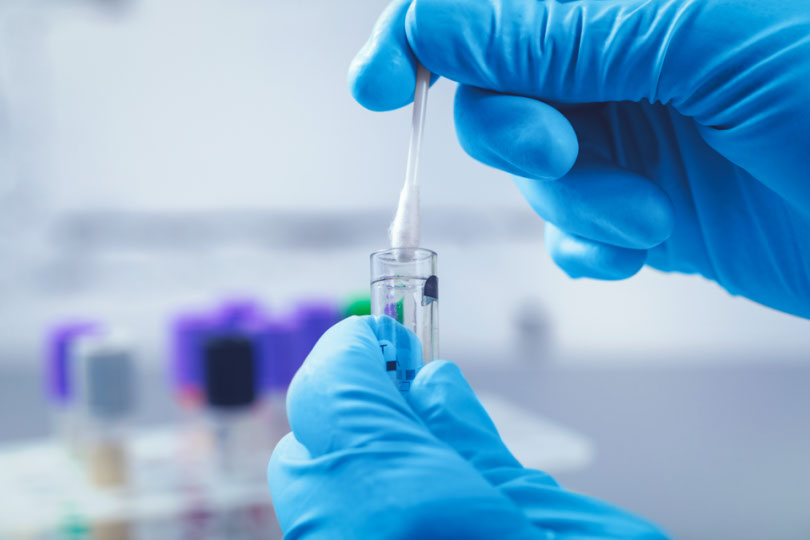
Importance of understanding antigen and NAAT tests
Understanding antigens as well as NAAT (Nucleic Acid Amplification Test) tests is of vital importance due to a variety of reasons:
- Accurate diagnosis Understanding the distinctions between these tests can help health professionals and patients choose the most appropriate method for diagnosis. A precise diagnosis is crucial to ensure timely and efficient diagnosis and treatment.
- Disease Control: Knowing the strengths and weaknesses that each test has is essential in preventing the spread of diseases that are infectious. Antigen tests could provide rapid results but may not be able to detect certain diseases, while NAATs offer more sensitivity and accuracy, however, they can take longer.
- Clinical Decision-Making: Healthcare providers need to make informed decisions regarding patient care based on the results of tests. Knowing which test to utilize for specific clinical situations ensures your patients get the best treatment and medical care.
- Public Health Measures: Public health officials and policymakers depend on accurate tests to make the right the right decisions about measures to protect public health like isolation, quarantine, or vaccination plans. What type of tests that are used will influence the decision-making process in a major way?
- Screening and surveillance: Antigen tests are frequently used for screening and surveillance because of their speed which makes them useful tools in detecting potential outbreaks before they occur. Knowing when and how to utilize these tests can help improve the health of your community.
- Resources Allocation: Healthcare systems must efficiently allocate resources. Understanding the distinctions between the antigen and NAAT tests can help optimize resource allocation by relating the correct test to the appropriate clinical context.
- In the Vaccination Choices: in regards to vaccination campaigns, knowing the testing procedures is essential. Certain tests are utilized to measure the effectiveness of vaccination or determine its efficacy.
- Research and Development: Researchers and scientists who work on treatments and diagnostics require a deep knowledge of these tests in order to create new and better techniques for testing and therapies.
- Patient education: Patients as well as the general public gain by understanding these tests, as they are able to make informed decisions regarding their health and well-being.
- Economic Aspects: Understanding the cost effects of antigen tests in comparison to NAATs is essential for budgeting in healthcare and planning financials.
Knowing the antigens or NAAT tests is vital to ensure accurate diagnosis, efficient disease control, well-informed clinical decision-making, and general treatment of infectious diseases. It plays an essential role in ensuring the health of individuals and the health of the public at large.
Comparison Table of Antigen and NAAT Test
Here’s a comparison table highlighting the key differences between antigen and NAAT (Nucleic Acid Amplification Test) tests:
| Aspect | Antigen Test | NAAT Test |
|---|---|---|
| Targeted Molecule | Viral or bacterial antigens | Nucleic acids (DNA or RNA) |
| Sensitivity | Lower sensitivity | High sensitivity |
| Specificity | Moderate specificity | High specificity |
| Speed of Results | Rapid (15-30 minutes) | Slower (several hours to days) |
| Primary Use | Screening and quick results | Confirmation and high accuracy |
| Cost | Relatively lower cost | Generally higher cost |
| Detection Window | Best for detecting active infections | Detects genetic material, including both active and past infections |
| Complexity | Simple and user-friendly | Complex laboratory procedures |
| False Negatives | More likely with a low viral load | Less likely due to high sensitivity |
| False Positives | Possible due to lower specificity | Less likely due to high specificity |
| Clinical Context | Initial assessment or mass screening | Confirmation, clinical diagnosis |
| Common Applications | COVID-19 rapid tests, flu tests | PCR tests for various infections |
| Equipment and Training | Minimal equipment and training required | Specialized equipment and expertise needed |
| Public Health Surveillance | Useful for early detection of outbreaks | Critical for tracking and understanding disease spread |
| Vaccine Monitoring | Limited utility for vaccine monitoring | Valuable for assessing vaccine efficacy |
| Research and Development | May not provide detailed genetic information | Provides genetic details for research |
| Typical Examples | BinaxNOW, BD Veritor, QuickVue | RT-PCR, PCR, TMA, LAMP, etc. |
Please note that while this table provides a general comparison, specific characteristics of antigen and NAAT tests may vary depending on the manufacturer and the specific pathogen being tested. Healthcare professionals should always consider the context and clinical requirements when selecting a testing method.
Advantages and disadvantages of antigen tests
Antigen tests come with a number of advantages and disadvantages that are suitable for certain situations, but not suitable for other situations.
Here’s a list of the major advantages and disadvantages of tests for antigen:
Advantages of Antigen Tests:
- Fast Results: The tests for antigens provide the results within a small period of time, usually between 15 and 30 minutes. This rapid turnaround is important in cases where immediate results are required for screening, like airports, or for quick clinical decision-making.
- Usability: Antigen tests are generally less complicated and don’t require special laboratory equipment or highly skilled personnel to interpret and administer the results. They are commonly utilized in the point-of-care setting.
- Cost-effective: Antigen tests are typically more affordable than molecular tests such as NAATs (Nucleic Acid Amplification Tests) making them suitable for large-scale testing and screening efforts.
- Mass screening: With their high speed, and cost-effectiveness the antigen tests are ideally suited to a large-scale screening of populations which helps to identify possible outbreaks and limit the spread of infectious diseases.
Disadvantages of Antigen Tests:
- Lower Sensitivity: Antigen tests typically are less sensitive compared to NAATs. They can miss infections that have lower levels of bacterial or viral loads and result in false-negative findings. This means that they’re less effective in diagnosing early or asymptomatic illnesses.
- moderate specificity: Antigen test results are offered only to the target pathogen, they could also result in false positive results, particularly in areas that have a very low prevalence of disease. A follow-up test is needed.
- limited diagnostic window: The tests for antibodies are the most effective at identifying active infections when the bacterial or viral load is very high. They might not be appropriate to detect infections in the beginning stages, or in the latter stages, where viral shedding is reduced.
- Is not suitable for confirmation Tests: Antigen tests are usually used to determine the need for screening. Positive results from antigen tests must be confirmed by an additional NAAT to eliminate false positives, particularly in clinical environments.
- Pathogen Specificity: Each test for an antigen is specific to a specific pathogen. Therefore, a distinct test is necessary for each infection being tested for. This restricts their flexibility when compared to NAATs that can be modified to suit different pathogens.
- Limited Application to Asymptomatic Cases: Antigen tests could be conducted less accurately in patients who are not symptomatic due to the fact that they generally are less virally active than those with symptoms.
Tests for antigens provide speed, efficiency, and cost-effectiveness, which makes an excellent tool for quick screening and monitoring. However their lower sensitivity as well as sometimes false-positive results, they’re best suited to situations where an immediate examination is required and followed by confirmation tests whenever necessary.
Healthcare professionals must consider the benefits and drawbacks of antigen tests before selecting the test method to use.
Advantages and disadvantages of NAATs
Nucleic Acid Amplification Tests (NAATs) offer a variety of advantages and disadvantages, making them a useful diagnostic tool to identify infectious diseases However, they do possess some drawbacks.
Here’s a list of principal advantages and disadvantages of NAATs:
Advantages of NAATs:
- High-Sensitivity: NAATs are renowned for their sensitivity. This makes them capable of detecting extremely low levels of targeted the pathogen’s genetic material. They are extremely efficient in detecting infections, particularly at the beginning of the disease as well as in patients who have low levels of pathogens.
- High Specificity: NAATs are extremely specific, meaning they have a lower chance of yielding false positive results since they are developed to detect specific genetic sequences that identify the target pathogen.
- Accurate Diagnosis: Because of their specificity and sensitivity, NAATs offer accurate and reliable diagnostics which makes them the standard for confirmation that there are no infectious agents.
- Flexibility: NAATs can be used to detect a diverse variety of pathogens, such as bacteria, viruses, and parasites, through targeting particular genetic markers. This flexibility makes them ideal for the treatment of various infections.
- Quantitative Analysis: Certain NAATs provide quantitative data on the amount of pathogens present in the sample. This could be useful in evaluating the progression of disease and treatment effectiveness.
- Early Detection: NAATs can detect infection at an early stage of the disease, usually before the first symptoms appear which is vital for prompt intervention and preventing the spread of disease.
Disadvantages of NAATs:
- Complexity: NAATs can be technically complex and often require specialized lab equipment and skilled personnel to carry out the tests. The complexity of NAATs can make them unsuitable for point-of-care tests or in settings with limited resources.
- Time-consuming: NAATs often require longer processing time compared to fast tests like antigen tests. Based on the test method and the lab workflow, results could take anywhere from a few hours to several days.
- High Cost: The NAAT is likely to cost more than quick tests, mostly because of testing equipment, chemicals, and the skilled personnel needed. This can be a hindrance to testing on a large scale, particularly in settings with limited resources.
- Not Suitable for Mass Screening: Time and costs associated with NAATs make them ineffective for mass screening on a large scale for tests at airports or events where speedy results are vital.
- Complex sample preparation: Preparing samples for NAATs can be time-consuming and requires caution when handling in order to prevent contamination that could alter the accuracy of the test.
- Genetic Variability: Certain pathogens can display genetic variability that could affect their accuracy NAATs in the event that the gene marker targeted alters over time.
NAATs are highly sensitive and precise diagnostic tools that can provide precise and prompt screening for infectious diseases. However, their complexity, price, and long turnaround times could limit their usage in certain cases of screening and clinical.
Healthcare professionals should take into consideration the advantages and disadvantages of these methods when deciding on the best test method for their particular scenario.
Antigen tests generally have lower sensitivity and specificity compared to NAATs
Antigen tests typically are less sensitive and specific in comparison to Nucleic acid Amplification Testing (NAAT).
Let’s go over these concepts further:
- Sensitivity: The term “sensitivity” refers to the test’s ability to accurately determine if a person has an illness (true positives). Antigen tests are fast and efficient in screening, can be less sensitive than NAATs. Therefore, antigen tests could not always identify the presence of a pathogen, especially in cases of less bacterial or viral load or in the initial stages of the infection. This is why antigen tests can produce false-positive results.
- Specificity: Specificity is the ability of a test to detect individuals who don’t suffer from this disease (true positives). Antigen tests typically are moderately specific to high however, they may result in false positive results. In certain cases, antigen tests could be able to detect the presence of the pathogen, even though it’s not in fact present.
NAATs are, on their own well-known for their excellent sensitivity and specificity. They can detect low levels of pathogen’s genetic material with excellent precision, which makes them reliable to confirm the presence of the agent that causes infection.
The decision between tests for antigens and NAATs typically depends on the specific situation and the balance that is desired between speed and precision. Antigen tests are useful for rapid screening of individuals, particularly in cases where quick results are needed, but they might require follow-up by more specific NAATs to confirm when precision is essential.
Healthcare professionals should take into consideration the context of their practice, the degree of disease, and the characteristics of performance of the test prior to choosing which test to take.
NAATs are more costly due to the complexity of the procedure
NUCLEIC Acid Amplification Tests (NAATs) are typically more expensive than tests for antigens due to the complicated methods involved.
There are a few factors that can contribute to the increased costs of NAATs:
- Labor Equipment: NAATs need specialized laboratory equipment, like thermal cyclers that are used for the polymerase chain reaction (PCR) as well as similar techniques for amplification. They can be costly to buy, maintain, and run.
- Reagents: NAATs employ specific primers, reagents, and probes that are designed to focus on and amplify the DNA of pathogens that are being examined. The reagents used can be expensive as well and their consistency and quality are vital to the accuracy of tests.
- Skilled personnel: Performing NAATs requires skilled laboratory workers who are skilled in molecular biology techniques. The hiring and retention of skilled workers can increase the expense of the testing.
- Quality Control: Quality controls, which include periodic calibrations of the equipment as well as monitoring test performance, are crucial to maintaining the reliability and accuracy of NAATs. These measures are a part of the total cost.
- Storage and Handling of Samples: Proper sample collection handling, storage, and handling are essential for NAATs for exact results. There could be additional charges to transport and store the samples.
- Validation and certification: NAATs frequently need validation or certification in order to guarantee conformity with standards set by regulators which can result in costs that are not included in the standard.
- Process Time: Processing time is longer for NAATs, in comparison to the speedy antigen tests could result in higher costs for labor and an increase in the use of resources.
While NAATs cost more they provide the benefits of sensitivity and specificity at a high level and are therefore the most appropriate option for confirmation of whether there is an infection particularly when accuracy is crucial. Antigen tests, however, are faster and cost less, however, they may be limited in terms of sensitivity and specificity.
The decision on NAATs as well as antigen testing varies on the particular clinical situation test objectives, the purpose of testing, and the resources available. Healthcare providers need to evaluate the cost versus the advantages of each testing method in order to make an informed decision.
Interpretation of results and clinical implications
Understanding findings from antigen as well as NAAT (Nucleic Acid Amplification Test) tests, as well as understanding their clinical implications is vital for both healthcare professionals and patients.
This article provides a broad review of how results from these tests are assessed and the clinical implications they have:
Antigen Test Results Interpretation:
- Positive Result:
- Clinical Implications: A positive antigen test results indicate an absence of specific bacterial or viral antigens within the patient’s samples. It indicates an active infection by the pathogen.
- Clinical action: Healthcare providers may suggest isolation, treatment by contact tracing, and additional diagnostic tests for confirmation or assessment of severity. Health authorities in the public sector can implement strategies to stop this disease’s spread.
- Negative Result:
- Clinical Implications: A negative test for antigens indicates the absence of discernible levels of viral or bacterial antigens present in the patient’s specimen at the moment of testing. However, it is not enough to exclude any possibility of infection, particularly in the beginning stages or when there are low viral load.
- Clinical action: Depending on the medical context and the symptoms health professionals may suggest following-up tests, especially when there is a strong likelihood of infection. False negative results are possible and the clinical judgment of the doctor is crucial.
NAAT Test Results Interpretation:
- Positive Result:
- Clinical Implications: A positive NAAT result suggests the presence of the genetic material of the pathogen (DNA or RNA) within the patient’s specimen. It’s a clear sign of an active disease.
- Clinical action: Healthcare providers typically take a positive NAAT test as a definitive diagnosis of infection. Treatment is isolation, treatment, and contact tracing can be initiated if needed.
- Negative Result:
- Clinical Implications: The negative NAAT result implies that there is no detectable genetic substance from the pathogen in the patient’s specimen at the time of the test. But, like antigen tests, it can not entirely rule out an infection possibility particularly in the initial stages or in cases of minimal pathogen load.
- Clinical action: Depending on clinical suspicion, symptoms, as well as history of exposure, health professionals may suggest a repeat test or alternative testing methods. False-negative results are possible as well, and a clinical diagnosis is vital.
It’s crucial to keep in mind how the interpreter of results from tests must be based on the context of the patient’s illness as well as the patient’s symptoms and exposure to the disease, and the frequency of the disease within the general population. In some instances, confirmatory testing is required to determine the diagnosis definitively, especially when the clinical manifestation is not in line with the results of the test.
Both the antigen as well as NAAT tests can have limitations in terms of sensitivity, specificity, or the time of collection. These limitations must be taken into consideration when interpreting results and making clinical judgments. Individuals and healthcare providers must follow the advice of public health officials and medical professionals when it comes to the proper management and testing of infections.
Similarities Between Antigen and NAAT Test
In spite of their distinct characteristics in terms of the antigen in addition to NAAT (Nucleic Acid Amplification Test) tests share a few similarities in their function and use in the diagnosis of infections.
Here are a few common features between these two kinds of tests:
- Diagnostic Tests: Antigen tests and NAAT tests can be used as diagnostic tests that are used to determine any infectious agent, for instance, bacteria or viruses, within a sample of a patient’s body. They are designed to give an indication of whether or not the pathogen is present within the body.
- Infectious Disease Detection: Both tests can be used to detect an array of diseases that are infectious, such as respiratory illnesses (e.g. COVID-19 or influenza) as well as sexually transmitted diseases (e.g., HIV, Chlamydia) and various microbiological diseases.
- Clinical utility: Both types of tests are beneficial instruments in clinical medicine to aid in the diagnosis and treatment of patients. Health professionals utilize the results to help make treatment decisions isolate patients suffering from infection and then implement the appropriate public health measures.
- Sample Collection: Tests for NAAT and antigen generally necessitate the taking of biosamples including nasopharyngeal samples, throat swabs as well as blood specimens, based on the test being performed and the pathogen being tested.
- Laboratory-based: Both kinds of tests are typically conducted in lab settings however, rapid antigen tests can be conducted in point-of-care facilities because of their ease of use.
- Quality Control: Quality controls are vital for both NAAT and antigen tests to ensure the accuracy and reliability of the results. Correct handling of samples and methods of handling are crucial.
- Control of Regulatory Oversight: Both tests fall under oversight from regulatory agencies as well as quality control measures to guarantee their security and efficacy for use in clinical settings.
- The impact on public health: Both tests play significant roles in the public health field such as disease surveillance monitoring of outbreaks, and tracking of contact. They help in understanding the transmission and prevalence of infections within communities.
- Follow-up testing: In certain cases particularly when the results are not conclusive or there is a need to confirm that both NAAT and antigen tests might require follow-up tests to verify the initial results.
- World Response to Pandemics: These tests have been a key part of the worldwide response to pandemics like COVID-19, a pandemic. They’ve been used in a wide range of tests to identify and distinguish infected individuals.
Although NAAT and antigen tests have a lot in common It is important to understand their distinctions, especially in terms of sensitivity, precision as well as speed of results, and price, since these variables affect their functions in clinical practice as well as public health programs. The decision of which test to choose is dependent on the particular situation and the testing goals.
Conclusion
Antigen as well as NAAT (Nucleic Acid Amplification Test) tests play a crucial role in diagnosing infections Each with its own advantages and drawbacks. Antigen tests are quick and cost-effective, which is ideal for screening quickly, while NAATs have high sensitivity and precision and are therefore essential for confirming the diagnosis.
The selection of the two tests is based on the context of the patient and the combination of speed and precision needed for efficient disease management. Understanding the differences and similarities is vital for health professionals as well as individuals looking for a timely and accurate diagnosis of infectious diseases.

